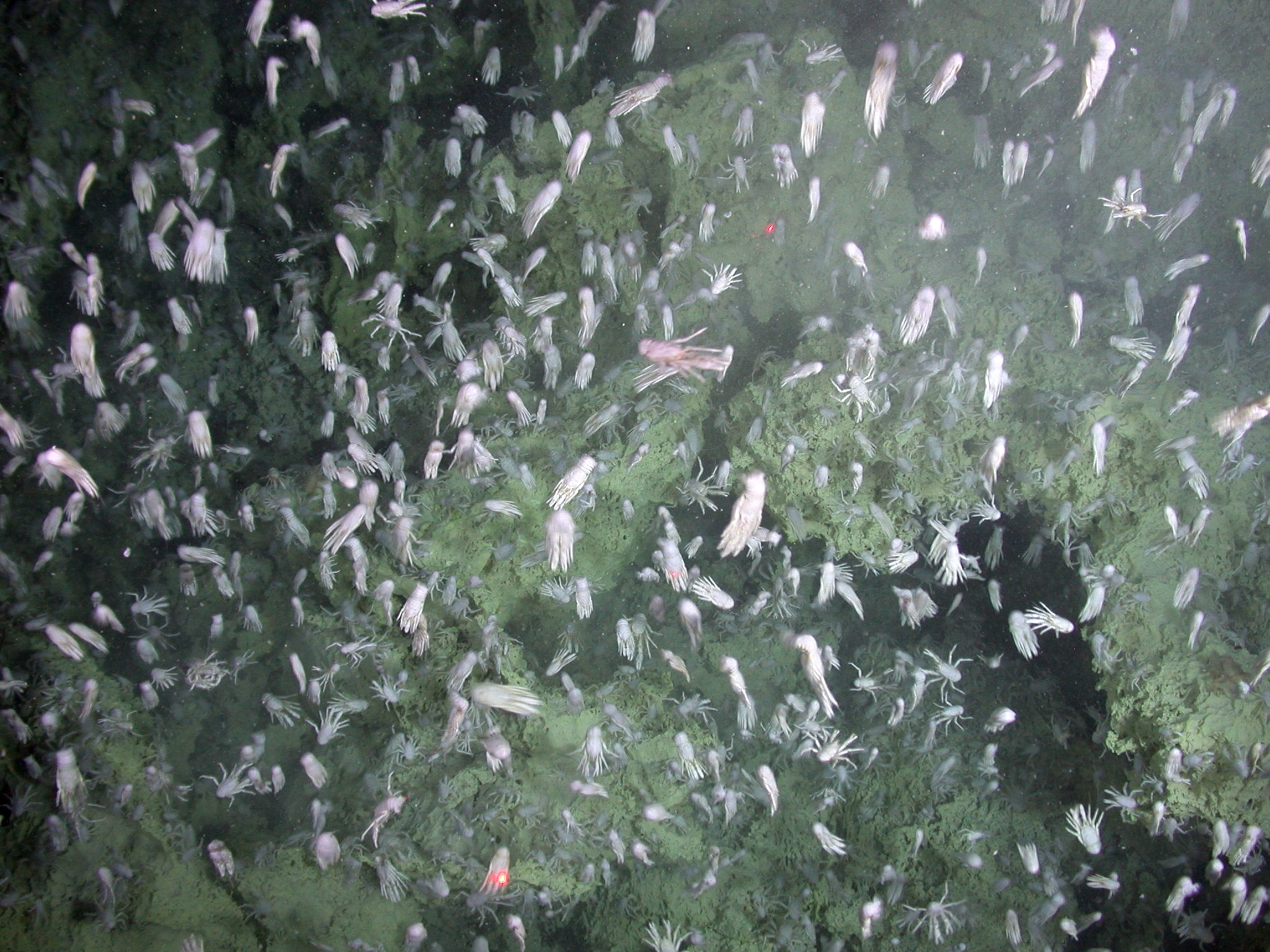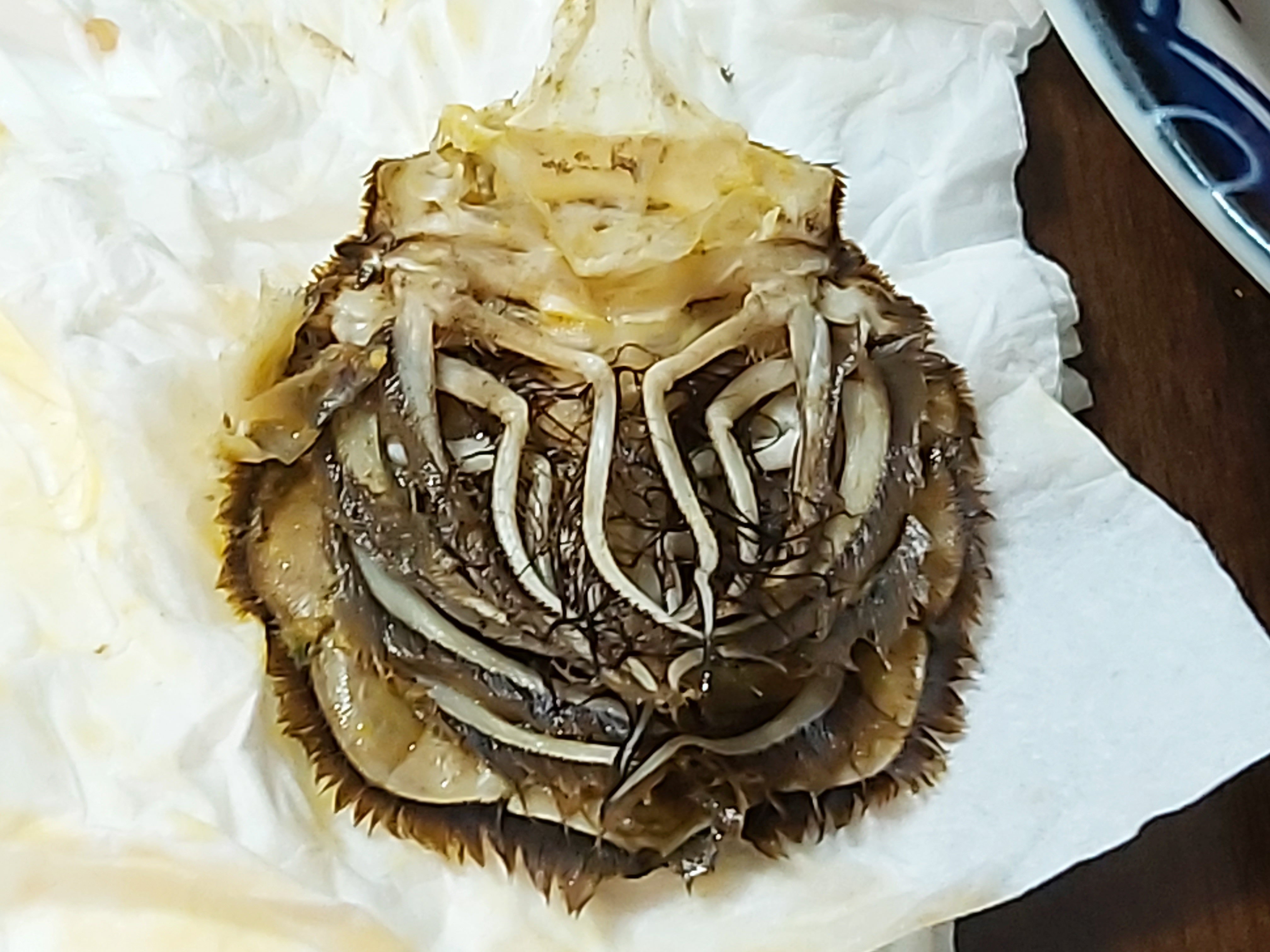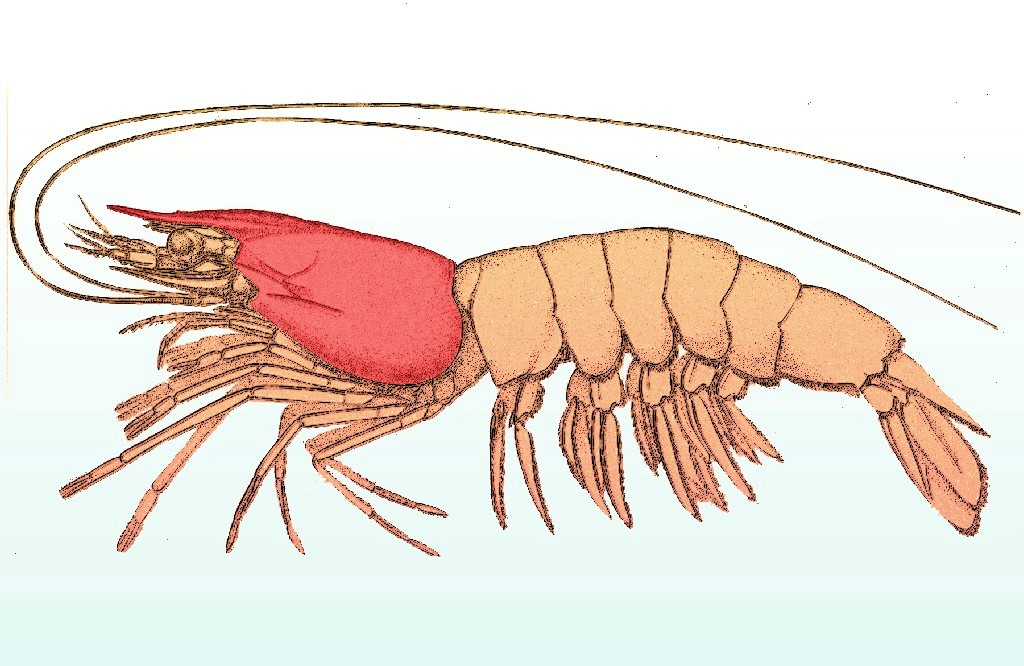|
Squat Lobsters
Squat lobsters are dorsoventrally flattened crustaceans with long tails held curled beneath the cephalothorax. They are found in the two superfamilies Galatheoidea and Chirostyloidea, which form part of the decapod infraorder Anomura, alongside groups including the hermit crabs and mole crabs. They are distributed worldwide in the oceans, and occur from near the surface to deep sea hydrothermal vents, with one species occupying caves above sea level. More than 900 species have been described, in around 60 genera. Some species form dense aggregations, either on the sea floor or in the water column, and a small number are commercially fished. Description The two main groups of squat lobsters share most features of their morphology. They resemble true lobsters in some ways, but are somewhat flattened dorsoventrally, and are typically smaller, ranging from 0.7 to 3.5 inches in length. Squat lobsters vary in postorbital carapace length (measured from the eye socket to the rear edge), ... [...More Info...] [...Related Items...] OR: [Wikipedia] [Google] [Baidu] |
Munidopsis Serricornis
''Munidopsis serricornis'' is a species of squat lobster. It is widely distributed in the world's oceans, being found in the eastern Atlantic Ocean (from Iceland and Norway to the Cape Verde Islands), the western Atlantic Ocean (from the United States to the Gulf of Mexico), and the Indo-Pacific (from Australia and the Malay Archipelago to Madagascar). It grows up to a carapace length of . ''M. serricornis'' appears to be one of the most abundant megafauna species in the cold water coral reefs of southern Norway. It has also been observed in association with the gorgonian ''Acanthogorgia''. ''M. serricornis'' was the first species of the current genus ''Munidopsis'' to be described, when Sven Lovén described it (as ''Galathea serricornis'') in 1852. It was described independently in 1857 under the name ''Galathea tridentata'' by Laurits Esmark. References {{Taxonbar, from=Q3656141 Squat lobsters Crustaceans described in 1852 ... [...More Info...] [...Related Items...] OR: [Wikipedia] [Google] [Baidu] |
Water Column
The (oceanic) water column is a concept used in oceanography to describe the physical (temperature, salinity, light penetration) and chemical ( pH, dissolved oxygen, nutrient salts) characteristics of seawater at different depths for a defined geographical point. Generally, vertical profiles are made of temperature, salinity, chemical parameters at a defined point along the water column. The water column is the largest, yet one of the most under-explored, habitats on the planet; it is explored to better understand the ocean as a whole, including the huge biomass that lives there and its importance to the global carbon and other biogeochemical cycles. Studying the water column also provides understanding on the links between living organisms and environmental parameters, large-scale water circulation and the transfer of matter between water masses. Water columns are used chiefly for environmental studies evaluating the stratification or mixing of thermal or chemically stratif ... [...More Info...] [...Related Items...] OR: [Wikipedia] [Google] [Baidu] |
Maxilla (arthropod Mouthpart)
In arthropods, the maxillae (singular maxilla) are paired structures present on the head as mouthparts in members of the clade Mandibulata, used for tasting and manipulating food. Embryologically, the maxillae are derived from the 4th and 5th segment of the head and the maxillary palps; segmented appendages extending from the base of the maxilla represent the former leg of those respective segments. In most cases, two pairs of maxillae are present and in different arthropod groups the two pairs of maxillae have been variously modified. In crustaceans, the first pair are called maxillulae (singular maxillula). Modified coxae at the base of the pedipalps in spiders are also called "maxillae", although they are not homologous with mandibulate maxillae. Myriapoda Millipedes In millipedes, the second maxillae have been lost, reducing the mouthparts to only the first maxillae which have fused together to form a gnathochilarium, acting as a lower lip to the buccal cavity and the ... [...More Info...] [...Related Items...] OR: [Wikipedia] [Google] [Baidu] |
Mandible (arthropod Mouthpart)
250px, The mandibles of a bull ant The mandible (from or mandĭbŭ-lum, a jaw) of an arthropod is a pair of mouthparts used either for biting or cutting and holding food. Mandibles are often simply called jaws. Mandibles are present in the extant subphyla Myriapoda (millipedes and others), Crustacea and Hexapoda (insects etc.). These groups make up the clade Mandibulata, which is currently believed to be the sister group to the rest of arthropods, the clade Arachnomorpha (Chelicerata and Trilobita). Unlike the chelicerae of arachnids, mandibles can often be used to chew food. Mandibulates also differ by having antennae, and also by having three distinct body regions: head, thorax and abdomen. (The cephalothorax (or prosoma) of chelicerates is a fusion of head and thorax.) Insects Insect mandibles are as diverse in form as their food. For instance, grasshoppers and many other plant-eating insects have sharp-edged mandibles that move side to side. Most butterflies ... [...More Info...] [...Related Items...] OR: [Wikipedia] [Google] [Baidu] |
Antenna (biology)
An antenna (plural: antennae) is one of a pair of appendages used for Sensory system, sensing in arthropods. Antennae are sometimes referred to as ''feelers''. Antennae are connected to the first one or two Segmentation (biology), segments of the arthropod head. They vary widely in form but are always made of one or more jointed segments. While they are typically sensory organs, the exact nature of what they sense and how they sense it is not the same in all groups. Functions may variously include sensing tactition, touch, air motion, heat, vibration (sound), and especially insect olfaction, smell or gustation, taste. Antennae are sometimes modified for other purposes, such as mating, brooding, swimming, and even anchoring the arthropod to a substrate (biology), substrate. Larval arthropods have antennae that differ from those of the adult. Many crustaceans, for example, have free-swimming larvae that use their antennae for swimming. Antennae can also locate other group members i ... [...More Info...] [...Related Items...] OR: [Wikipedia] [Google] [Baidu] |
Kiwa Puravida
''Kiwa puravida'' is a species of deep-sea dwelling decapod and a member of the genus '' Kiwa'', a genus of animals that are informally known as yeti crabs, after the mythical, hairy creature. This allusion is due to the long, hair-like structures on their claws. Yeti crabs use these hairs to cultivate symbiotic bacteria on their claws which they feed upon. Description The specific epithet ''puravida'' (translating to "pure life") comes from a Costa Rican Spanish saying (used to answer "How are you doing?" or to say "Thanks"), a homage to where it was discovered. The yeti crab is typically found to be less than 6 inches in length, weighing 2-5 pounds. Additionally, they typically live up to 10-20 years. ''Kiwa puravida'' is placed under the “Bristly” clade of ''Kiwa'', along with ''Kiwa'' sp. GM, and '' Kiwa araonae''. Fossil records indicate that these crabs originated from hydrothermal vents in the East Pacific 38 to 33 million years ago and experienced rapid radiat ... [...More Info...] [...Related Items...] OR: [Wikipedia] [Google] [Baidu] |
Pleon
The anatomy of a decapod consists of 20 body segments grouped into two main body parts: the cephalothorax and the pleon (abdomen). Each segment – often called a somite – may possess one pair of appendages, although in various groups these may be reduced or missing. Cephalothorax Head #antennules #antenna (biology), antennae #mandible (arthropod)#Crustaceans, mandibles #Maxilla (arthropod), first maxillae #Maxilla (arthropod), second maxillae The head also bears the (usually stalked) compound eyes. The distal portion of a mandible or maxilla which has a sensory function is known as a palp. Thorax / pereon #first maxillipeds #second maxillipeds #third maxillipeds #first pereiopods #second pereiopods #third pereiopods #fourth pereiopods #fifth pereiopods Maxillipeds are appendages modified to function as mouthparts. Particularly in the less advanced decapods, these can be very similar to the pereiopods. Pereiopods are primarily walking arthropod leg, legs and are also used for ... [...More Info...] [...Related Items...] OR: [Wikipedia] [Google] [Baidu] |
Uroptychus
''Uroptychus'' is a genus of squat lobsters in the family Chirostylidae found across the Indo-Pacific The Indo-Pacific is a vast biogeographic region of Earth. In a narrow sense, sometimes known as the Indo-West Pacific or Indo-Pacific Asia, it comprises the tropical waters of the Indian Ocean, the western and central Pacific Ocean, and the .... The genus ''Uroptychus'' contains the following species: References External links * * Squat lobsters Long stubs with short prose {{Squat-lobster-stub ... [...More Info...] [...Related Items...] OR: [Wikipedia] [Google] [Baidu] |
Galathea Intermedia
''Galathea intermedia'' is a species of squat lobster in the family Galatheidae. It is found in the north-eastern Atlantic Ocean, as far north as Troms, Norway, south to Dakar and the Mediterranean Sea. ''G. intermedia'' is the smallest species of squat lobster in the North Sea, at a length of only , and a carapace length of . The whole body is red, with a beige stripe along the back, onto the narrow rostrum Rostrum may refer to: * Any kind of a platform for a speaker: **dais **pulpit ** podium * Rostrum (anatomy), a beak, or anatomical structure resembling a beak, as in the mouthparts of many sucking insects * Rostrum (ship), a form of bow on naval .... The limbs are semitransparent, and the animal bears several "neon blue" spots on the front of the body that may serve in species recognition. References Squat lobsters Anomura of the Atlantic Ocean Fauna of the Mediterranean Sea Crustaceans described in 1851 Taxa named by Wilhelm Lilljeborg {{squat-lobster-st ... [...More Info...] [...Related Items...] OR: [Wikipedia] [Google] [Baidu] |
Munidopsis Aries
''Munidopsis'' is a genus of squat lobster. It is the second largest of all the genera of squat lobsters, after ''Munida'', with over 200 species. Its members are mainly found on continental slopes and on abyssal plains. A few fossil species are also known, including specimens from the Campanian (Cretaceous). Diversity There are currently over 230 known species. Distribution ''Munidopsis'', like other squat lobsters, are often found in chemosynthetic environments in the ocean. ''Munidopsis'' was the first confirmed genus to inhabit the underwater Mud volcano habitat. Most ''Munidopsis'' species are found in the deep sea at depths more than 5300m. In 2022, during surveys of the wreck of the ''Endurance'', a squat lobster believed to be an unidentified species in the ''Munidopsis'' genus was observed. Historical significance The genus Munidopsis dates back to the Eocene and Upper Cretaceous The Late Cretaceous (100.5–66 Ma) is the more recent of two epochs into w ... [...More Info...] [...Related Items...] OR: [Wikipedia] [Google] [Baidu] |
Carapace
A carapace is a dorsal (upper) section of the exoskeleton or shell in a number of animal groups, including arthropods, such as crustaceans and arachnids, as well as vertebrates, such as turtles and tortoises. In turtles and tortoises, the underside is called the plastron. In botany, a carapace refers to the hard outer cover of a seed which protects the inner embryo. Crustaceans In crustaceans, the carapace functions as a protective cover over the cephalothorax (i.e., the fused head and thorax, as distinct from the abdomen behind). Where it projects forward beyond the eyes, this projection is called a rostrum. The carapace is calcified to varying degrees in different crustaceans. Zooplankton within the phylum Crustacea also have a carapace. These include Cladocera, ostracods, and isopods, but isopods only have a developed "cephalic shield" carapace covering the head. Arachnids In arachnids, the carapace is formed by the fusion of prosomal tergites into a single pl ... [...More Info...] [...Related Items...] OR: [Wikipedia] [Google] [Baidu] |



